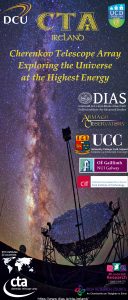
Public Open Night Wednesday October 11th
Two talks on the Cherenkov Telescope Array. Gates open at 7:00 pm
Book here
Dr Masha Chernyakova:
New frontiers in science with the Cherenkov Telescope Array.
Abstract: The Cherenkov Telescope Array (CTA), will be the Major Global Observatory for very High Energy Gamma-Ray Astronomy over the next decade and beyond. The scientific potential of CTA is extremely broad: from understanding the role of Relativistic Cosmic Particles to the search for Dark Matter. CTA is an explorer of the extreme universe, probing environments from the immediate neighbourhood of Black Holes to Cosmic Voids on the largest scales. In my talk I will overview the most exiting discoveries that CTA should be able to do.
Prof. John Quinn
The Cherenkov Telescope Array: Instrumentation for Exploring the Very High Energy Universe
Abstract: The Cherenkov Telescope Array (CTA) is a next-generation astronomical facility, currently in the design and prototyping phase, for exploring the Very High Energy (VHE) gamma-ray Universe. The energy range covered by CTA will be from 20 GeV to 300 TeV, allowing for the study of nature’s most powerful particle accelerators, associated with black holes, neutron stars and supernova remnants,
in unprecedented detail (for comparison, the LHC at CERN accelerates protons to energies up to 14 TeV). CTA is being developed by a global consortium of scientists and will have two observatories, one in the northern hemisphere on La Palma in the Canary Islands, and the other in the southern hemisphere at ESO’s Paranal site in Chile. Gamma-ray telescopes are usually placed on satellites in space to get above the Earth’s atmosphere, but CTA will actually use the atmosphere to detect gamma rays via the faint flashes of blue Cherenkov light that are produced when gamma rays are destroyed through interactions with air molecules. In this talk an overview will be given of the CTA telescopes and how they work, and the significant role Irish scientists played in developing this exciting young branch of astronomy will be highlighted.
Leave a Comment
Last Updated: 23rd May 2018 by Anne Grace
CTA Public Event in Dunsink Observatory
Public Open Night Wednesday October 11th
Two talks on the Cherenkov Telescope Array. Gates open at 7:00 pm
Book here
Dr Masha Chernyakova:
New frontiers in science with the Cherenkov Telescope Array.
Abstract: The Cherenkov Telescope Array (CTA), will be the Major Global Observatory for very High Energy Gamma-Ray Astronomy over the next decade and beyond. The scientific potential of CTA is extremely broad: from understanding the role of Relativistic Cosmic Particles to the search for Dark Matter. CTA is an explorer of the extreme universe, probing environments from the immediate neighbourhood of Black Holes to Cosmic Voids on the largest scales. In my talk I will overview the most exiting discoveries that CTA should be able to do.
Prof. John Quinn
The Cherenkov Telescope Array: Instrumentation for Exploring the Very High Energy Universe
Abstract: The Cherenkov Telescope Array (CTA) is a next-generation astronomical facility, currently in the design and prototyping phase, for exploring the Very High Energy (VHE) gamma-ray Universe. The energy range covered by CTA will be from 20 GeV to 300 TeV, allowing for the study of nature’s most powerful particle accelerators, associated with black holes, neutron stars and supernova remnants,
in unprecedented detail (for comparison, the LHC at CERN accelerates protons to energies up to 14 TeV). CTA is being developed by a global consortium of scientists and will have two observatories, one in the northern hemisphere on La Palma in the Canary Islands, and the other in the southern hemisphere at ESO’s Paranal site in Chile. Gamma-ray telescopes are usually placed on satellites in space to get above the Earth’s atmosphere, but CTA will actually use the atmosphere to detect gamma rays via the faint flashes of blue Cherenkov light that are produced when gamma rays are destroyed through interactions with air molecules. In this talk an overview will be given of the CTA telescopes and how they work, and the significant role Irish scientists played in developing this exciting young branch of astronomy will be highlighted.
Category: Astronomy and Astrophysics, Astronomy and Astrophysics Section News & Events, News
Recent Posts
DIAS Astrophotography competition goes mobile for 2024
Irish scientists are part of groundbreaking discovery with James Webb Space Telescope
Dr Pauline Gagnon (formerly of CERN) to deliver two talks at DIAS
DIAS Professor announced as next President of the European Southern Observatory’s Council
Quake Shake: New programme encourages people to get involved in monitoring earthquakes
Language switcher